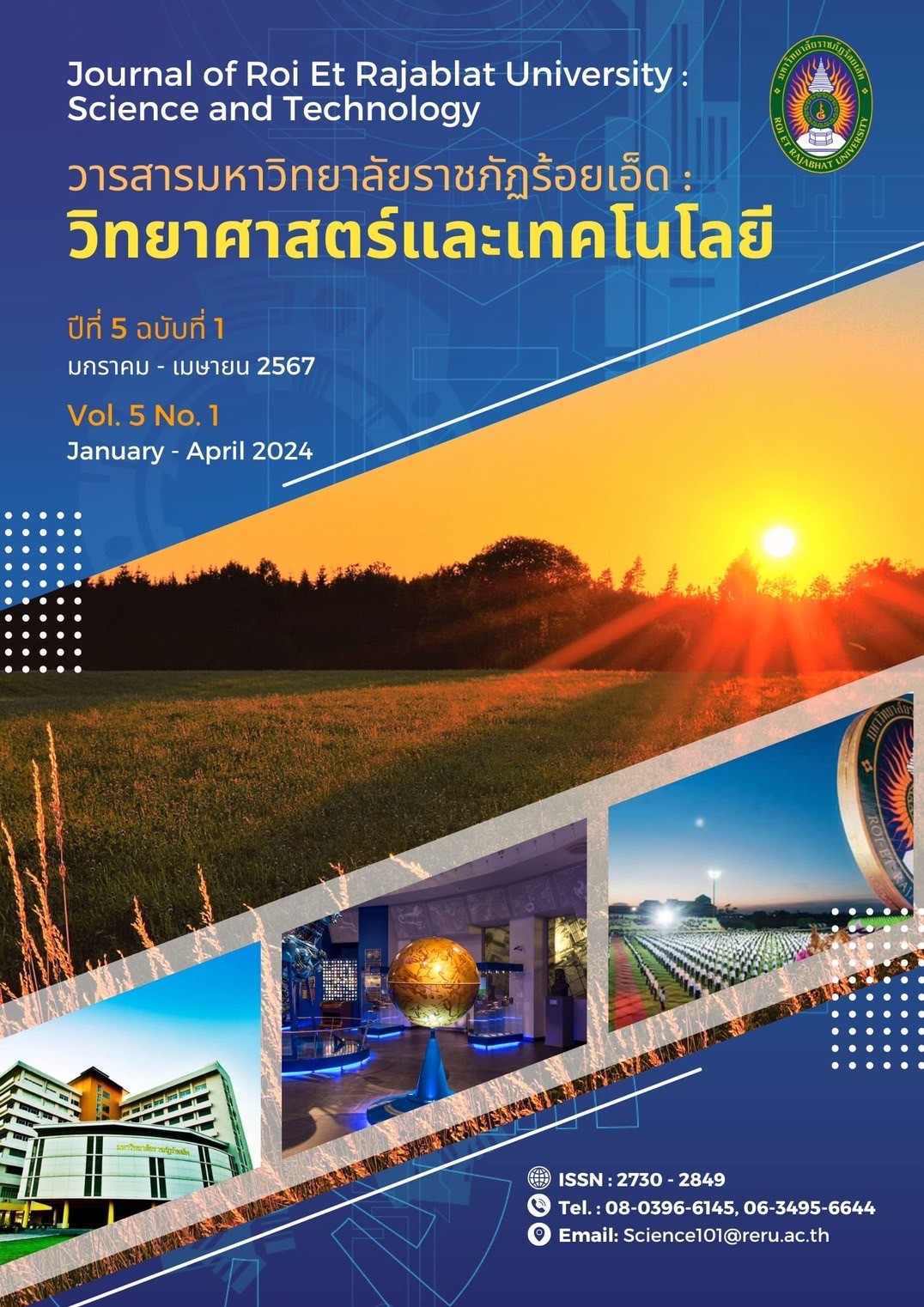Effect of difference drying temperature on phenolic compounds and antioxidant capacity of Lithocarpus ceriferu
Abstract
The objective of this research was to investigate the impact of drying at various temperatures on the alterations in antioxidant activity and bioactive compounds of Makor (Lithocarpus ceriferus). The samples were dried by hot air drying at 40 degree celsius (ºC) and 80 ºC. It was found that the total phenolic content was in the range of 24.62-42.38 mg GAE/g db and the total flavonoid content was in the range of 0.89-1.16 mg RE/g db. The findings of the Makor drying experiment revealed the presence of 11 distinct phenolic acids, along with their respective quantities. These phenolic acids include gallic acid, protocatechuic acid, p-hydroxybenzoic acid, vanillic acid, chlorogenic acid, caffeic acid, syringic acid, p-coumaric acid, ferulic acid, sinapic acid and gentisic acid. The analysis showed that the total phenolic acid content was 1,115.47 µg/g db. Through the analysis of flavonoid compounds, four flavonoids were identified in the samples. These flavonoids are rutin, myricetin, quercetin, and apigenin. Furthermore, the total flavonoid content was determined to be 367.48 µg/g db. However, kaempferol was not found in the samples. The results of the antioxidant activity showed that the FRAP assay was in the range of 18.20- 27.81 mgFeSO4/g db and the DPPH radical scavenging activity was in the range of 7.30- 9.03 mg Trolox/g db, respectively. Drying Makor at varying temperatures has been observed to have distinct impacts on the levels of chemical constituents. Specifically, high-temperature drying methods have been found to influence the content of bioactive compounds and antioxidant activities in Makor products.
References
Hongwiwat, N. & Hongwiwat, T. (2007). Makor in 111 types of fruits: The value of food and eating. Bangkok. Sangdad.
Chumroenphat, T., Somboonwatthanakul, I., Saensouk, S. & Siriamornpun, S. (2019). The diversity of biologically active compounds in the rhizomes of recently discovered Zingiberaceae plants native to North Eastern Thailand. Pharmacognosy Journal. 11 (5),1014-1022. https://doi:10.5530/pj.2019.11.160
Chumroenphat, T., Somboonwatthanakul, I., Saensouk, S. & Siriamornpun, S. (2020). Changes in curcuminoids and chemical components of turmeric (Curcuma longa L.) under freeze-drying and low-temperature drying methods. Food Chemistry. 339, 128121. https://doi: 10.1016/j.foodchem.2020.128121
Pereira-Lorenzo, S., Ramos-Cabrer, A.M., Díaz-Hernández, M., Ciordia-Ara, M. & Ríos-Mesa, D. (2006). Chemical composition of chestnut cultivars from Spain. Scientia Horticulturae. 107, 306–314. https://doi.org/10.1016/j.scienta.2005.08.008
Siriamornpun, S. & Kaewseejan, N. (2017). Quality, bioactive compounds and antioxidant capacity of
selected climacteric fruits with relation to their maturity. Scientia Horticulturae, 221, 33-42. https://doi.org/10.1016/j.scienta.2017.04.020
Wanyo, P., Meeso, N. & Siriamornpun, S. (2014). Effects of different treatments on the antioxidant properties and phenolic compounds of rice bran and rice husk. Food Chemistry. 157, 457–463. https://doi: 10.1016/j.foodchem.2014.02.061
Yu, J.M., Nam, M. & Kim, M-S. (2022). Metabolite profiling of chestnut (Castanea crenata) according to origin and harvest time using 1H NMR spectroscopy. Foods. 11, 1325. https://doi.org/10.3390/foods11091325
Downloads
Published
How to Cite
Issue
Section
License
Copyright (c) 2024 Faculty of Liberal Art and Science, Roi-Ed Rajabhat University

This work is licensed under a Creative Commons Attribution-NonCommercial-NoDerivatives 4.0 International License.
บทความที่ได้รับการตีพิมพ์เป็นลิขสิทธิ์ของคณะศิลปศาสตร์และวิทยาศาสตร์ มหาวิทยาลัยราชภัฏร้อยเอ็ด
ข้อความที่ปรากฏในบทความแต่ละเรื่องในวารสารวิชาการเล่มนี้เป็นความคิดเห็นส่วนตัวของผู้เขียนแต่ละท่านไม่เกี่ยวข้องกับมหาวิทยาลัยราชภัฎร้อยเอ็ด และคณาจารย์ท่านอื่นๆในมหาวิทยาลัยฯ แต่อย่างใด ความรับผิดชอบองค์ประกอบทั้งหมดของบทความแต่ละเรื่องเป็นของผู้เขียนแต่ละท่าน หากมีความผิดพลาดใดๆ ผู้เขียนแต่ละท่านจะรับผิดชอบบทความของตนเองแต่ผู้เดียว





